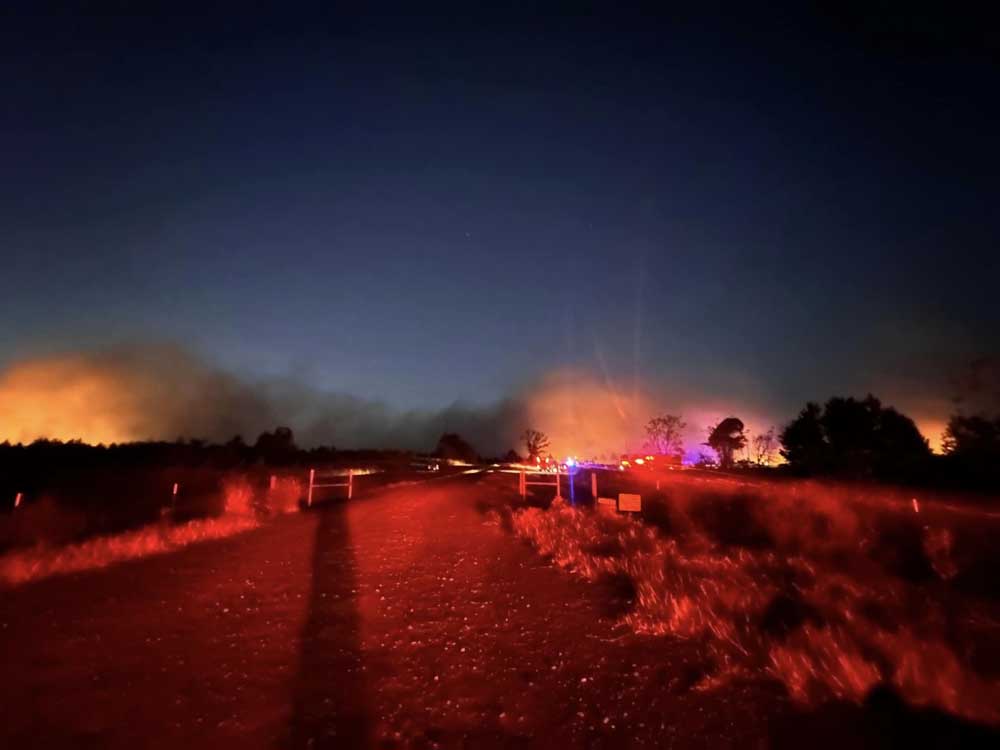Despite rainfall, burn ban remains in effect in Smith County
Published 5:30 pm Thursday, October 31, 2024

- Like Smith County, other local counties have burn bans in effect due to high fire danger. On Tuesday, a fire burned over 50 acres in Rusk County. (Eastside Volunteer Fire Department/Contributed Photo)
Even after receiving much-needed rain on Thursday, fire danger remains high in Smith County and surrounding areas.
“Although the rainfall helped ease the potential of wildfires, it was not enough to alleviate the fire dangers countywide for an extended period of time,” Smith County Fire Marshal Chad Hogue said Thursday afternoon. “There are chances for rain in the next few days, which could eliminate the need for the burn ban, but we must wait and see.”
As of 3 p.m., Smith County officials had responded to eight calls of illegal burning.
Hogue recommended a continuation of the burn ban and updated commissioners on the current fire conditions during the Smith County Commissioners Court meeting Tuesday. He plans to give an update to the court at its meeting next Tuesday.
The Keetch-Byram Drought Index (KBDI) for Smith County is at an average of 751 as of Thursday afternoon. The KBDI ranges from 0 to 800, and is used to determine forest fire potential.
Wednesday’s rainfall marks “the first measurable rainfall in 35 consecutive days,” according to the CBS19 meteorology team.
Fire danger has been especially high because of strong winds.
“The 15-20 mph wind today makes it even more difficult for fire crews to control and extinguish wildfires,” Hogue said Tuesday.
There have been 225 “fire incidents” in Smith County since the burn ban was enacted on Oct. 8. These include calls responded to by the Emergency Services Districts 1 and 2 that serve out in the county.
The Smith County Fire Marshals Office has given out 20 to 25 citations, Hogue said, adding that he did not know how many citations have been given by the Sheriff’s Office or Constables’ Offices.
Violating the burn ban is a Class C misdemeanor, punishable by a fine up to $500.
Other counties have experienced high fire danger and some remain under burn bans. In Rusk County this week, a 50-acre fire continued to blaze. The large fire, off County Road 438, was about 75% contained as of 8:45 p.m. Tuesday. While the biggest fire is located on County Road 438, others were reported on County Roads 324, 401, 4188, 438 and 376.
Some of the local bans last 90 days, while others last shorter periods but can be extended.
The risk of wildfires in East Texas has increased dramatically. High winds and drought conditions that have persisted for weeks could cause wildfires with “extreme intensity,” according to the Texas A&M Forest Service’s wildfire index.
The index, or KBDI, measures soil moisture and precipitation. The higher the rating the forest service gives a county, the greater the potential for forest fires is. Like Smith County’s current rating, the forest service has given many counties in the area a rating of over 700, short of the maximum forest fire potential of 800.
It’s been over a month since measurable precipitation fell in the Tyler area, according to the National Weather Service in Shreveport.
Armani Cassel, a meteorologist at the Shreveport office, said in the past year, the region has been in an El Nino weather pattern, but it is transitioning into a La Nina weather pattern. During a La Nina pattern, the southern portion of the U.S. tends to be warmer and drier, while the northern portion tends to be cooler and wetter.
“What it really means for us is a drier winter,” Cassel said. “Drier and hotter this winter.”
The first major cool front of the season has moved into the region and has been dry, contributing to drought conditions, Cassel said. A high pressure system also exacerbates the problem, pushing rain and storm systems further north toward the Great Plains and Midwest.
The region can expect higher winds as cool fronts move through. The fall tends to be windier than the summer.
Cassel reminds people to be mindful of burn bans and consider less obvious safety hazards that could spark a fire, such as chains dragging from vehicles.
About a fourth of the country is in moderate drought, according to NOAA’s weather outlook.






